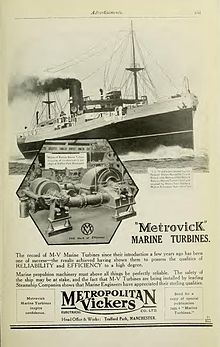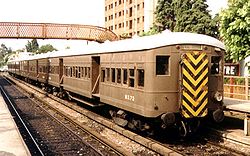- Metropolitan-Vickers
-
Metropolitan-Vickers 
Type private (subsidiary or joint ownership) Industry heavy electrical engineering Fate brand removed in 1960, ultimately part of GEC from 1967 Metropolitan-Vickers, Metrovick, or Metrovicks, was a British heavy electrical engineering company of the early-to-mid 20th century formerly known as British Westinghouse. Highly diversified, they were particularly well known for their industrial electrical equipment such as generators, steam turbines, switchgear, transformers, electronics and railway traction equipment. Metrovick holds a place in history as the builders of the first commercial transistor computer, the Metrovick 950, and the first British axial-flow jet engine, the Metrovick F.2. Their factory in Trafford Park, Manchester, was for most of the 20th century one of the biggest and most important heavy engineering facilities in Britain and the world.
Contents
History
Metrovick started as a way to separate the existing British Westinghouse Electrical and Manufacturing Company factories from United States control, which had proven to be a hindrance to gaining government contracts during World War I. In 1917 a holding company was formed to try to find financing to buy the company's properties.[1]
In May 1917, control of the holding company was obtained jointly by the Metropolitan Carriage, Wagon and Finance Company, of Birmingham, chaired by Frank Dudley Docker, and Vickers Limited, of Barrow-in-Furness.[1][2] On 15 March 1919, Docker agreed terms with Vickers, for Vickers to purchase all the shares of the Metropolitan Carriage, Wagon and Finance Company for almost thirteen million pounds.[1][2][3] On 8 September 1919, Vickers changed the name of the British Westinghouse Electrical and Manufacturing Company to Metropolitan Vickers Electrical Company.[1][2]
The immediate post-war era was marked by low investment and continued labour unrest. Fortunes changed in 1926 with the formation of the Central Electricity Board which standardized electrical supply and led to a massive expansion of electrical distribution, installations, and appliance purchases. Sales shot up, and 1927 marked the company's best year to date.
BTH merger and transition to AEI
In 1928 Metrovick merged with the rival British Thomson-Houston (BTH), a company of similar size and basically the same product lineup. Combined, they would be one of the few companies able to compete with Marconi or English Electric on an equal footing. In fact the merger was marked by poor communication and intense rivalry, and the two companies generally worked at cross purposes. The next year the combined company was purchased by the Associated Electrical Industries (AEI) holding group, who also owned Edison Swan (Ediswan); also Ferguson & Pailin, manufacturers of electrical switchgear in Openshaw, Manchester. Rivalry between Metrovick and BTH continued, and AEI was never able to exert effective control over the two competing subsidiary companies.
Problems worsened in 1929 with the start of the great depression, but Metrovick's overseas sales were able to pick up some of the slack, notably a major railway electrification project in Brazil. By 1933 world trade was growing again, but growth was nearly upset when six Metrovick engineers were arrested and found guilty of espionage and "wrecking" in Moscow after a number of turbines built by the company in and for the Soviet Union proved to be faulty. The British government intervened; the engineers were released and trade with Russia was resumed after a brief embargo.
During the 1930s Metropolitan Vickers produced two dozen very large diameter (3m/10 ft) three-phase AC traction motors [1] for the Hungarian railway's V40 and V60 electric locomotives. The 1640 kW rated power machinery, designed by Kálmán Kandó, was paid for by British government economic aid.
In 1935 the company built a 105 MW steam turbogenerator, the largest in Europe at that time, for the Battersea powerstation.[4]
In 1936 Metrovick started work with the Air Ministry on automatic pilot systems, eventually branching out to gunlaying systems and building radars the next year. In 1938 they reached an agreement with the Ministry to build a turboprop design developed at the RAE under the direction of Haine Constant. It is somewhat ironic that BTH, their erstwhile partners, were at the same time working with Frank Whittle on his pioneering jet designs.
Wartime aircraft production
In mid-1938, MV's were given a contract to build Avro Manchester twin-engined heavy bombers under licence from A.V. Roe. As this type of work was very different from their traditional heavy engineering activities, a new factory was built on the western side of Mosley Road and this was completed in stages through 1940, to be supplied with Rolls-Royce Merlin engines from the Ford Trafford Park shadow factory. The first 13 Manchesters were destroyed in a Luftwaffe bombing raid on Trafford Park on 23 December, but the firm went on to complete 43 examples. With the design of the much improved four-engined derivative, the Avro Lancaster, MV switched production to that famous type. Three hangars were erected on the southside of Manchester's Ringway Airport for assembly and testing of their Lancasters, before a policy switch was made to assembling them in a hangar at Avro's Woodford airfield. By the end of the war, MV's had built 1,080 Lancasters. These were followed by 79 Avro Lincoln derivatives before remaining orders were cancelled and MV's aircraft production ceased in December 1945. In 1940 the turboprop effort was re-engineered as a pure jet engine after the successful run of Whittle's designs. The new design became the Metrovick F.2 and eventually flew in 1943 on a Gloster Meteor. Considered to be too complex to bother with, Metrovick then re-engineered the design once again to produce roughly double the power, while at the same time starting work on a much larger design, the Metrovick F.9 Sapphire. Although the F.9 proved to be a winner, the Ministry of Supply nevertheless forced the company to sell the jet division to Armstrong Siddeley in 1947 to reduce the number of companies in the business.
In addition to building aircraft, other wartime work included the manufacture of both Dowty and Messier undercarriages, automatic pilot units, searchlights and radar equipment.
Metrovicks postwar
The post-war era led to massive demand for electrical systems, leading to additional rivalries between Metrovick and BTH as each attempted to one-up the other in delivering ever-larger turbogenerator contracts. Metrovick also expanded their appliance division during this time, becoming a well known supplier of refrigerators and stoves.
The design and manufacture of sophisticated scientific instruments, such as electron microscopes, and mass spectrometers, became an important area of scientific research for the company.
In 1947 a Metrovick G.1 Gatric gas turbine was fitted to the Motor Gun Boat MGB 2009, making it the world's first gas turbine powered naval vessel.
Another major area of expansion was in the diesel locomotive market, where they combined their own generators and traction motors, with third-party diesel engines to develop in 1950 the WAGR X class 2-Do-2 locomotive and in 1958 the type 2 Co-Bo, later re-classified under the TOPS system as the British Rail Class 28. This diesel-electric locomotive was unusual on two counts; its Co-Bo wheel arrangement and its Crossley 2-Stroke diesel engine (evolved from a WW2 marine engine). Intended as part the British Railways Modernisation Plan, the twenty-strong fleet saw service between Scotland and England before being deemed unsuccessful and withdrawn towards the end of the 1960s. Metrovick also produced the CIE 001 Class (originally 'A' Class) from 1955, the first production mainline diesels in Ireland.
Metropolitan Vickers also produced electrical equipment for the British Rail Class 76 (EM1), and British Rail Class 77 (EM2), 1.5KV DC locomotives, built at Gorton Works for the electrification of the Woodhead Line in the early 1950s. The company also designed the British Rail Class 82, 25KV AC locomotives built by Beyer Peacock in Manchester using Metrovick electrical equipment. The company also supplied electrical equipment for the British Rail Class 303 "Blue Train" electric multiple units.
During the 1950s the company built a large power transformer works at Wythenshawe, near Manchester. The factory was opened in 1957 and later closed by GEC in 1971, after which it was sold to the American compressor manufacturer Ingersoll Rand.
In 1961, the Russian astronaut Yuri Gagarin was invited to the company's factory at Trafford Park as part of his tour of Manchester.[5][6]
The rivalry between Metrovick and BTH was eventually ended in an unconvincing fashion when the AEI management eventually decided to rid themselves of both brands and be known as AEI universally, a change they made on 1 January 1960. This move was almost universally resented within both companies. Worse, the new brand name was utterly unknown to their customers, leading to a noticeable fall-off in sales and AEI's stock price.
GEC takeover
When AEI then went on to attempt to remove the doubled-up management structures, they found this task to be even more difficult. By the mid-1960s the company was struggling under the weight of two complete management hierarchies, and they appeared to be unable to control the company any more. This allowed AEI to be purchased by GEC in 1967, which was later restructured into many other companies, including Marconi plc in 1999, later Marconi Corporation plc, and others.
See also
- Category:Metropolitan Vickers locomotives
- Bowesfield Works
References
Notes
- ^ a b c d Scott (1963). P.140-142.
- ^ a b c Gillham (1988), Chapter 2: The Manufacturers.
- ^ Scott (1963). Appendix A.
- ^ http://www.scienceandsociety.co.uk/results.asp?image=10250275&wwwflag=3&imagepos=57
- ^ http://yurigagarin50.org/history/gagarin-in-britain
- ^ http://yurigagarin50.org/history/gagarin-in-britain/gagarin-in-manchester
Sources
- Scott, J.D. (1963). Vickers: A History. London: George Weidenfeld and Nicolson Ltd.
- Gillham, J.C. (1988). The Age of the Electric Train: Electric trains in Britain since 1883. London: Ian Allan Ltd. ISBN 0-7110-1392-6.
External links
- John Dummelow M.A., A.M.I.E.E. Metropolitan-Vickers Electrical Co. Ltd. 1899 - 1949. The History of a great company. More than 200 pages of text and pictures, on line.
- Frank Rowlinson. Contribution to Victory. Metropolitan-Vickers, Manchester, 1947. Contains 200 pages on MV's war effort with many illustrations.
- Nic Doncasters page on WAGR Crossleys
Lists relating to aviation General Aircraft (manufacturers) · Aircraft engines (manufacturers) · Airlines (defunct) · Airports · Civil authorities · Museums · Registration prefixes · Rotorcraft (manufacturers) · TimelineMilitary Accidents/incidents Records Categories:- Turbines
- Locomotive manufacturers of the United Kingdom
- Engineering companies of the United Kingdom
- Electrical engineering companies of the United Kingdom
- Defunct manufacturing companies of the United Kingdom
- Metropolitan-Vickers
- Radar
- Companies based in Manchester
- History of Manchester
- Defunct aircraft engine manufacturers of the United Kingdom
Wikimedia Foundation. 2010.



